Implementation and Performances Evaluation of Advanced Automotive Lateral Stability Controls on a Real-Time Hardware in the Loop Driving Simulator
Abstract
1. Introduction
2. Control Strategies
- (a)
- Steering angle is small: < 10 deg;
- (b)
- Vehicle longitudinal speed is constant: ;
- (c)
- Tire slip angles are small: deg;
- (d)
- Tire cornering stiffness is known and constant: .
2.1. Linear Quadratic Lateral Tracking Control
2.1.1. Controller Structure
2.1.2. LQR Controller Design
2.1.3. Brake Pressure Splitting Logic
- Checking if the wheel reaches the saturation limit;
- Definition of the pressure quantity by which the saturation limit is exceeded;
- Subtraction of this quantity from the wheel of the other side ensures the allocation of the control yaw moment.
2.2. Sliding Mode Lateral Stability Control
- High-level layer: which defines the control objective according to driver intention and vehicle states, for example, longitudinal speed, side-slip angle, yaw rate;
- Intermediate-level layer: consisting of a first-order Sliding Mode Controller;
- Low-level layer: devoted to the generation of the control references for the actuators, i.e., SBW, BBW, and traction motors.
2.2.1. Modeling Approach: High-Level Layer
2.2.2. Control Theory: Intermediate-Level Layer
2.2.3. Effort Application: Low-Level Layer
3. Real-Time Driving Simulator
- The Real-Time simulator: consisting in a concurrent-RT machine, which manages the simulation environment along with the vehicle model. For non-disclosure reasons, the detailed specifications of the benchmark Use Case (UC) cannot be described. However, it is implemented with stability CU, i.e., EBD, ABS, TCS, and commercial ESP solution. Moreover, it is assumed that the vehicle’s RWD powertrain is actuated to an active differential transmission system;
- The EPSiL steering bench: reproducing the real behavior of the steering system, including the Electric Power Steering system (EPS) and a steering wheel;
- The Braking unit: a by-wire system that includes all the components of a real disc brake plant with independent control of each wheel caliper. Moreover, a virtual sensing regulation loop is considered.
3.1. Epsil Steering Bench
3.2. Braking Unit
4. Simulation Results
4.1. Offline Test Campaigns: Tuning of the Controllers
4.2. Online Test Campaigns: Performance Evaluations
- Non-Controlled Scenario: in this case, the vehicle is driven without the assistance of any kind of lateral stability controller. Thus, it was possible to establish inner vehicle maneuverability and test the driver’s capabilities. Many free driving tests are conducted to identify the limit of controllability;
- Commercial-Controlled Scenario: tests are conducted with the Continental GmbH proprietary ESP controller. The strategy, from our side, is completely unknown. However, we can make some assumptions, supposing the control technique is advanced and represent the SoA of the industrial ESP solutions, which is actually implemented on different vehicles in the market.
- LQR-Controlled Scenario: the Linear Quadratic lateral Tracking Control is tested, thanks to the RT co-simulation capabilities of the virtual environment, between MATLAB Simulink and VI-Grade;
- SMC-Controlled Scenario: here, the Sliding Mode Lateral Stability Controller is investigated, exploiting the same control rig from the previous scenario (ESP in MATLAB Simulink and vehicle model in the VI-Grade).
4.3. Ramp Steer
4.4. Step Steer
4.5. Sine Steer
4.6. Lane Change
5. Conclusions and Future Developments
Author Contributions
Funding
Institutional Review Board Statement
Informed Consent Statement
Data Availability Statement
Conflicts of Interest
Abbreviations
| 4WD | Four Wheel Drive |
| ABS | Anti-lock Braking System |
| ASIL | Automotive Safety Integrity Level |
| BW | By-Wire |
| BBW | Brake-By-Wire |
| CoG | Centre of Gravity |
| CU | Control Unit |
| EBD | Electronic Braking Distributor |
| ESP | Electronic Stability Program |
| ESC | Electronic Stability Control |
| FWD | Front Wheel Drive |
| HiL | Hardware in the Loop |
| IWM | In-Wheel Motor |
| ICE | Internal Combustion Engine |
| LQR | Linear Quadratic Regulator |
| NL | Non-Linear |
| RWD | Rear Wheel Drive |
| TCS | Traction Control System |
| TV | Torque Vectoring |
| SBW | Steer-By-Wire |
| SMC | Sliding Mode Control |
| UC | Use Case |
References
- Nagai, M. The Perspectives of Research for Enhancing Active Safety Based on Advanced Control Technology. Veh. Syst. Dyn. 2007, 45, 413–431. [Google Scholar] [CrossRef]
- Reif, K. (Ed.) Automotive Mechatronics: Automotive Networking, Driving Stability Systems, Electronics; Springer Fachmedien Wiesbaden: Wiesbaden, Germany, 2015. [Google Scholar] [CrossRef]
- Frede, D.; Khodabakhshian, M.; Malmquist, D. A State-of-the-Art Survey on Vehicular Mechatronics Focusing on by-Wire Systems; KTH Royal Institute of Technology: Stockholm, Sweden, 2010. [Google Scholar]
- Navet, N.; Simonot-Lion, F.; Song, Y.Q.; Wilwert, C. Design of Automotive X-by-Wire Systems. In The Industrial Communication Technology Handbook; Industrial Information Technology; CRC Press: Boca Raton, FL, USA, 2005; Volume 20050668, pp. 29-1–29-19. [Google Scholar] [CrossRef]
- Gonzalez, D.; Perez, J.; Milanes, V.; Nashashibi, F. A Review of Motion Planning Techniques for Automated Vehicles. IEEE Trans. Intell. Transport. Syst. 2016, 17, 1135–1145. [Google Scholar] [CrossRef]
- Winner, H.; Hakuli, S.; Lotz, F.; Singer, C. (Eds.) Handbook of Driver Assistance Systems; Springer International Publishing: Cham, Switzerland, 2016. [Google Scholar] [CrossRef]
- Yu, L.; Liu, X.; Xie, Z.; Chen, Y. Review of Brake-by-Wire System Used in Modern Passenger Car. In Proceedings of the International Design Engineering Technical Conferences and Computers and Information in Engineering Conference, Charlotte, NC, USA, 21–24 August 2016. [Google Scholar]
- Rajamani, R.; Phanomchoeng, G.; Piyabongkarn, D.; Lew, J.Y. Algorithms for Real-Time Estimation of Individual Wheel Tire-Road Friction Coefficients. IEEE/ASME Trans. Mechatron. 2012, 17, 1183–1195. [Google Scholar] [CrossRef]
- Mangia, A.; Lenzo, B.; Sabbioni, E. An Integrated Torque-Vectoring Control Framework for Electric Vehicles Featuring Multiple Handling and Energy-Efficiency Modes Selectable by the Driver. Meccanica 2021, 56, 991–1010. [Google Scholar] [CrossRef]
- Ko, S.-Y.; Ko, J.-W.; Lee, S.-M.; Cheon, J.-S.; Kim, H. A Study on In-Wheel Motor Control to Improve Vehicle Stability Using Human-in-the-Loop Simulation. J. Power Electron. 2013, 13, 536–545. [Google Scholar] [CrossRef]
- Jin, B.; Sun, C.; Zhang, X. Research on lateral stability of four hubmotor-in-wheels drive electric vehicle. Int. J. Smart Sens. Intell. Syst. 2015, 8, 1855–1875. [Google Scholar] [CrossRef]
- Feng, C.; Ding, N.; He, Y.; Xu, G.; Gao, F. Control Allocation Algorithm for Over-Actuated Electric Vehicles. J. Cent. South Univ. 2014, 21, 3705–3712. [Google Scholar] [CrossRef]
- Montani, M.; Capitani, R.; Fainello, M.; Annicchiarico, C. Use of a Driving Simulator to Develop a Brake-by-Wire System Designed for Electric Vehicles and Car Stability Controls. In Proceedings of the 10th International Munich Chassis Symposium 2019; Pfeffer, P.E., Ed.; Springer Fachmedien Wiesbaden: Wiesbaden, Germany, 2020; pp. 663–684. [Google Scholar]
- Velenis, E.; Frazzoli, E.; Tsiotras, P. Steady-State Cornering Equilibria and Stabilisation for a Vehicle during Extreme Operating Conditions. Int. J. Veh. Auton. Syst. 2010, 8, 217. [Google Scholar] [CrossRef]
- Jagga, D.; Lv, M.; Baldi, S. Hybrid Adaptive Chassis Control for Vehicle Lateral Stability in the Presence of Uncertainty. In Proceedings of the 2018 26th Mediterranean Conference on Control and Automation (MED), Akko, Israel, 1–4 July 2018; IEEE: Zadar, Croatia, 2018; pp. 1–6. [Google Scholar] [CrossRef]
- Li, L.; Jia, G.; Chen, J.; Zhu, H.; Cao, D.; Song, J. A Novel Vehicle Dynamics Stability Control Algorithm Based on the Hierarchical Strategy with Constrain of Nonlinear Tyre Forces. Veh. Syst. Dyn. 2015, 53, 1093–1116. [Google Scholar] [CrossRef]
- Dal Poggetto, V.F.; Serpa, A.L. Vehicle Rollover Avoidance by Application of Gain-Scheduled LQR Controllers Using State Observers. Veh. Syst. Dyn. 2016, 54, 191–209. [Google Scholar] [CrossRef]
- Pugi, L.; Favilli, T.; Berzi, L.; Locorotondo, E.; Pierini, M. Brake Blending and Optimal Torque Allocation Strategies for Innovative Electric Powertrains. In Applications in Electronics Pervading Industry, Environment and Society; Saponara, S., De Gloria, A., Eds.; Lecture Notes in Electrical Engineering; Springer International Publishing: Cham, Switzerland, 2019; Volume 573, pp. 477–483. [Google Scholar] [CrossRef]
- Pugi, L.; Favilli, T.; Berzi, L.; Locorotondo, E.; Pierini, M. Brake Blending and Torque Vectoring of Road Electric Vehicles: A Flexible Approach Based on Smart Torque Allocation. Int. J. Electr. Hybrid Veh. 2020, 12, 87–115. [Google Scholar] [CrossRef]
- Montani, M.; Favilli, T.; Berzi, L.; Capitani, R.; Pierini, M.; Pugi, L.; Annicchiarico, C. ESC on In-Wheel Motors Driven Electric Vehicle: Handling and Stability Performances Assessment. In Proceedings of the 2020 IEEE International Conference on Environment and Electrical Engineering and 2020 IEEE Industrial and Commercial Power Systems Europe (EEEIC/I&CPS Europe), Madrid, Spain, 9–12 June 2020; pp. 1–6. [Google Scholar] [CrossRef]
- Chen, Y.; Chen, S.; Zhao, Y.; Gao, Z.; Li, C. Optimized Handling Stability Control Strategy for a Four In-Wheel Motor Independent-Drive Electric Vehicle. IEEE Access 2019, 7, 17017–17032. [Google Scholar] [CrossRef]
- Hu, J.-S.; Wang, Y.; Fujimoto, H.; Hori, Y. Robust Yaw Stability Control for In-Wheel Motor Electric Vehicles. IEEE/ASME Trans. Mechatron. 2017, 22, 1360–1370. [Google Scholar] [CrossRef]
- Alipour, H.; Sabahi, M.; Bannae Sharifian, M.B. Lateral Stabilization of a Four Wheel Independent Drive Electric Vehicle on Slippery Roads. Mechatronics 2015, 30, 275–285. [Google Scholar] [CrossRef]
- De Novellis, L.; Sorniotti, A.; Gruber, P.; Pennycott, A. Comparison of Feedback Control Techniques for Torque-Vectoring Control of Fully Electric Vehicles. IEEE Trans. Veh. Technol. 2014, 63, 3612–3623. [Google Scholar] [CrossRef]
- Ando, N.; Fujimoto, H. Yaw-Rate Control for Electric Vehicle with Active Front/Rear Steering and Driving/Braking Force Distribution of Rear Wheels. In Proceedings of the 2010 11th IEEE International Workshop on Advanced Motion Control (AMC), Nagaoka, Japan, 21–24 March 2010. [Google Scholar]
- Di Cairano, S.; Tseng, H.E.; Bernardini, D.; Bemporad, A. Vehicle Yaw Stability Control by Coordinated Active Front Steering and Differential Braking in the Tire Sideslip Angles Domain. IEEE Trans. Contr. Syst. Technol. 2013, 21, 1236–1248. [Google Scholar] [CrossRef]
- Dinçmen, E.; Acarman, T. Active Coordination of The Individually Actuated Wheel Braking and Steering To Enhance Vehicle Lateral Stability and Handling. IFAC Proc. Vol. 2008, 41, 10738–10743. [Google Scholar] [CrossRef]
- Guvenc, B.A.; Acarman, T.; Guvenc, L. Coordination of Steering and Individual Wheel Braking Actuated Vehicle Yaw Stability Control. In Proceedings of the IEEE IV2003 Intelligent Vehicles Symposium, Columbus, OH, USA, 9–11 June 2003; Proceedings (Cat. No.03TH8683). pp. 288–293. [Google Scholar] [CrossRef]
- Wang, J.; Longoria, R.G. Coordinated Vehicle Dynamics Control with Control Distribution. In Proceedings of the 2006 American Control Conference, Minneapolis, MN, USA, 14–16 June 2006; p. 6. [Google Scholar] [CrossRef]
- Tjonnas, J.; Johansen, T.A. Stabilization of Automotive Vehicles Using Active Steering and Adaptive Brake Control Allocation. IEEE Trans. Contr. Syst. Technol. 2010, 18, 545–558. [Google Scholar] [CrossRef]
- Yu, S.-H.; Moskwa, J.J. A Global Approach to Vehicle Control: Coordination of Four Wheel Steering and Wheel Torques. J. Dyn. Syst. Meas. Control 1994, 116, 659–667. [Google Scholar] [CrossRef]
- Bartolini, G.; Pisano, A.; Punta, E.; Usai, E. A Survey of Applications of Second-Order Sliding Mode Control to Mechanical Systems. Int. J. Control 2003, 76, 875–892. [Google Scholar] [CrossRef]
- Goggia, T.; Sorniotti, A.; De Novellis, L.; Ferrara, A.; Gruber, P.; Theunissen, J.; Steenbeke, D.; Knauder, B.; Zehetner, J. Integral Sliding Mode for the Torque-Vectoring Control of Fully Electric Vehicles: Theoretical Design and Experimental Assessment. IEEE Trans. Veh. Technol. 2015, 64, 1701–1715. [Google Scholar] [CrossRef]
- Tota, A.; Lenzo, B.; Lu, Q.; Sorniotti, A.; Gruber, P.; Fallah, S.; Velardocchia, M.; Galvagno, E.; De Smet, J. On the Experimental Analysis of Integral Sliding Modes for Yaw Rate and Sideslip Control of an Electric Vehicle with Multiple Motors. Int. J. Automot. Technol. 2018, 19, 811–823. [Google Scholar] [CrossRef]
- Canale, M.; Fagiano, L.; Ferrara, A.; Vecchio, C. Vehicle Yaw Control via Second-Order Sliding-Mode Technique. IEEE Trans. Ind. Electron. 2008, 55, 3908–3916. [Google Scholar] [CrossRef]
- Jin, J. Modified Pseudoinverse Redistribution Methods for Redundant Controls Allocation. J. Guid. Control Dyn. 2005, 28, 1076–1079. [Google Scholar] [CrossRef]
- Montani, M.; Vitaliti, D.; Capitani, R.; Annicchiarico, C. Performance Review of Three Car Integrated ABS Types: Development of a Tire Independent Wheel Speed Control. Energies 2020, 13, 6183. [Google Scholar] [CrossRef]
- Breuer, J.J. Analysis of driver-vehicle-interactions in an evasive manoeuvre-results of ‘moose test’ studies. In Proceedings of the 16th International Technical Conference on the Enhanced Safety of Vehicles (ESV), Windsor, ON, Canada, 31 May–4 June 1998. [Google Scholar]
- Talarico, E.M.; Raimondi, G.; Alfatti, F.; Vitaliti, D.; Annicchiarico, C. A Virtual Development Approach Using Advanced HiL Steering Bench; Springer: Berlin/Heidelberg, Germany, 2021; p. 16. [Google Scholar]
- Pančík, J.; Beneš, V. Emulation of Wheel Speed Sensors for Automotive Electronic Control Unit. In Industry 4.0: Trends in Management of Intelligent Manufacturing Systems; Knapčíková, L., Balog, M., Eds.; EAI/Springer Innovations in Communication and Computing; Springer International Publishing: Cham, Switzerland, 2019; pp. 111–120. [Google Scholar]
- Alfatti, F.; Annicchiarico, C.; Capitani, R. Vehicle Stability Controller HiL Validation on Static Simulator. IOP Proc. 2022, 1214, 012044. [Google Scholar] [CrossRef]
- Pacejka, H. Tire and Vehicle Dynamics; Elsevier: Amsterdam, The Netherlands, 2005. [Google Scholar]
- Hal, M. Is Vehicle Characterization in Accordance with Standard Test Procedures a Necessary Prerequisite for Validating Computer Models of a Test Vehicle? Master’s Thesis, Technological University Dublin, Dublin, Ireland, 2014. [Google Scholar] [CrossRef]

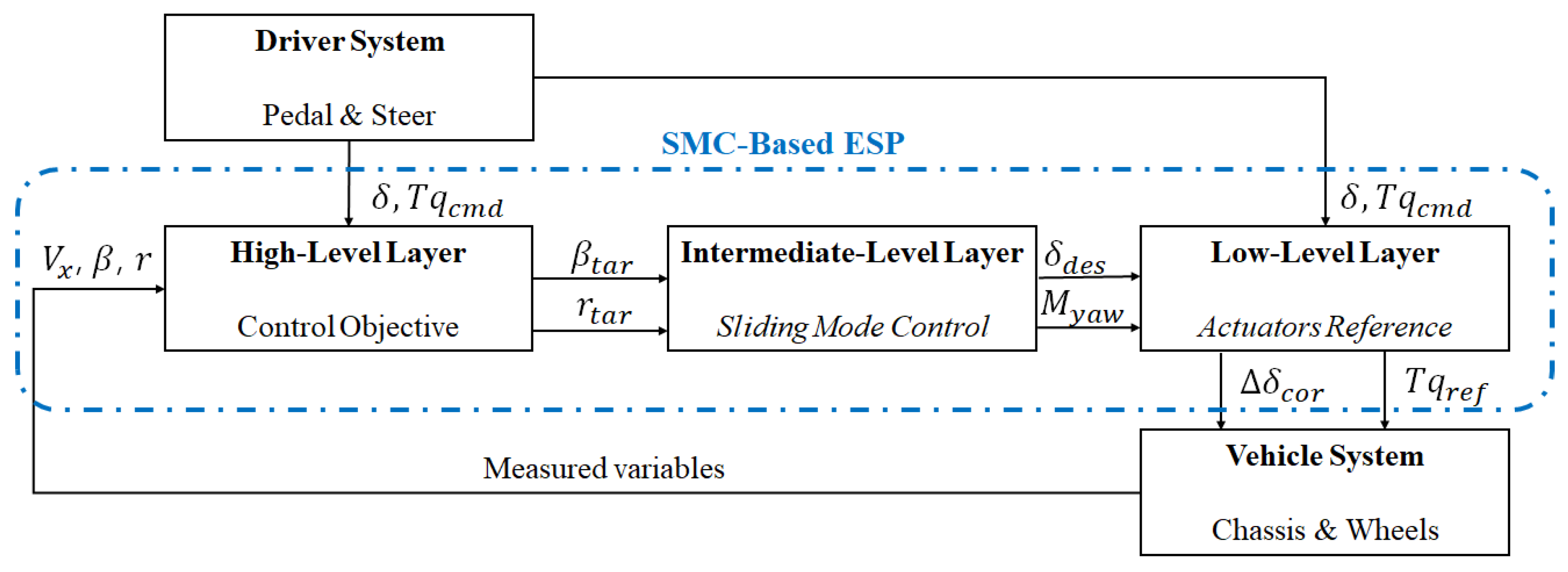
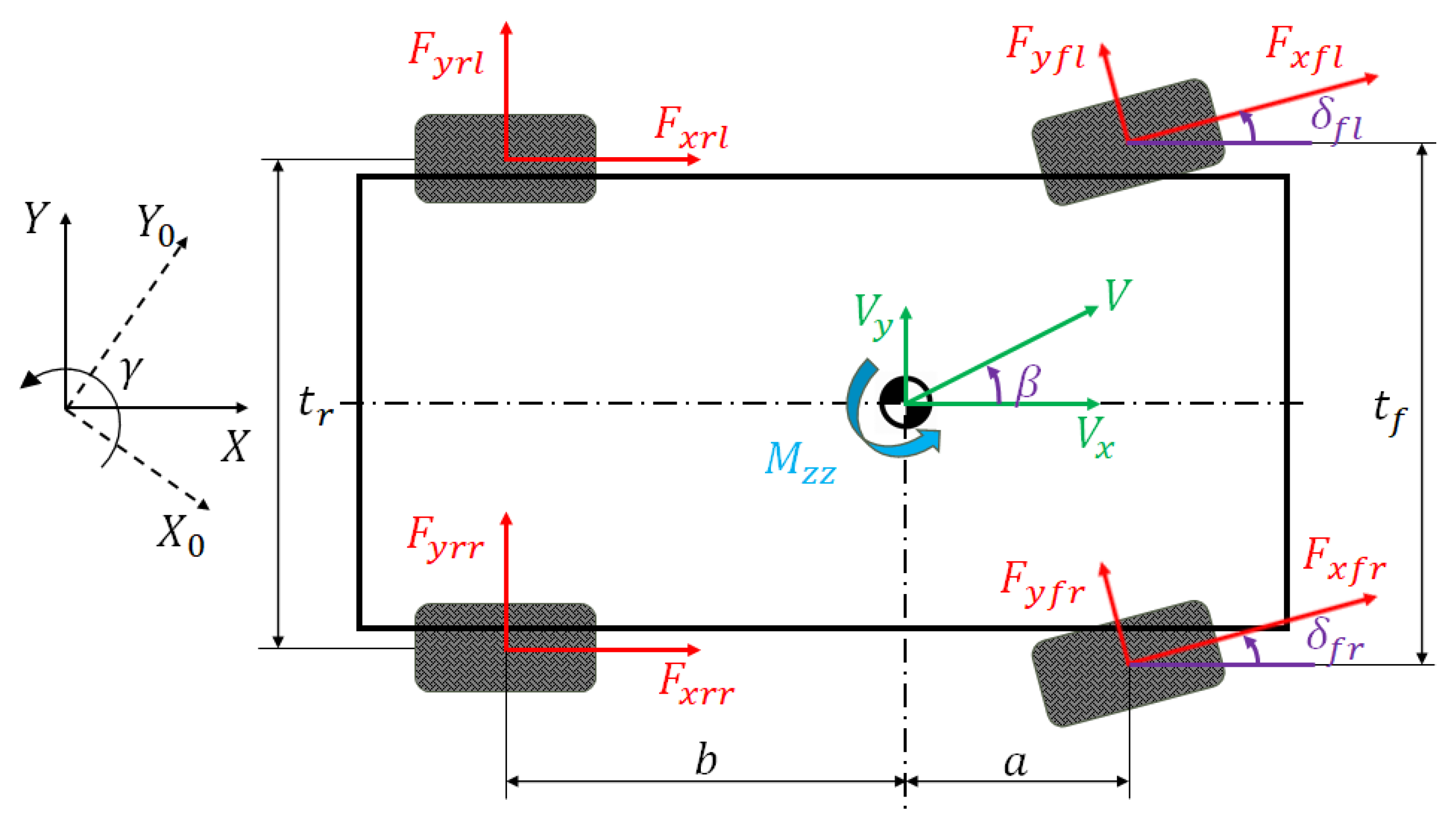

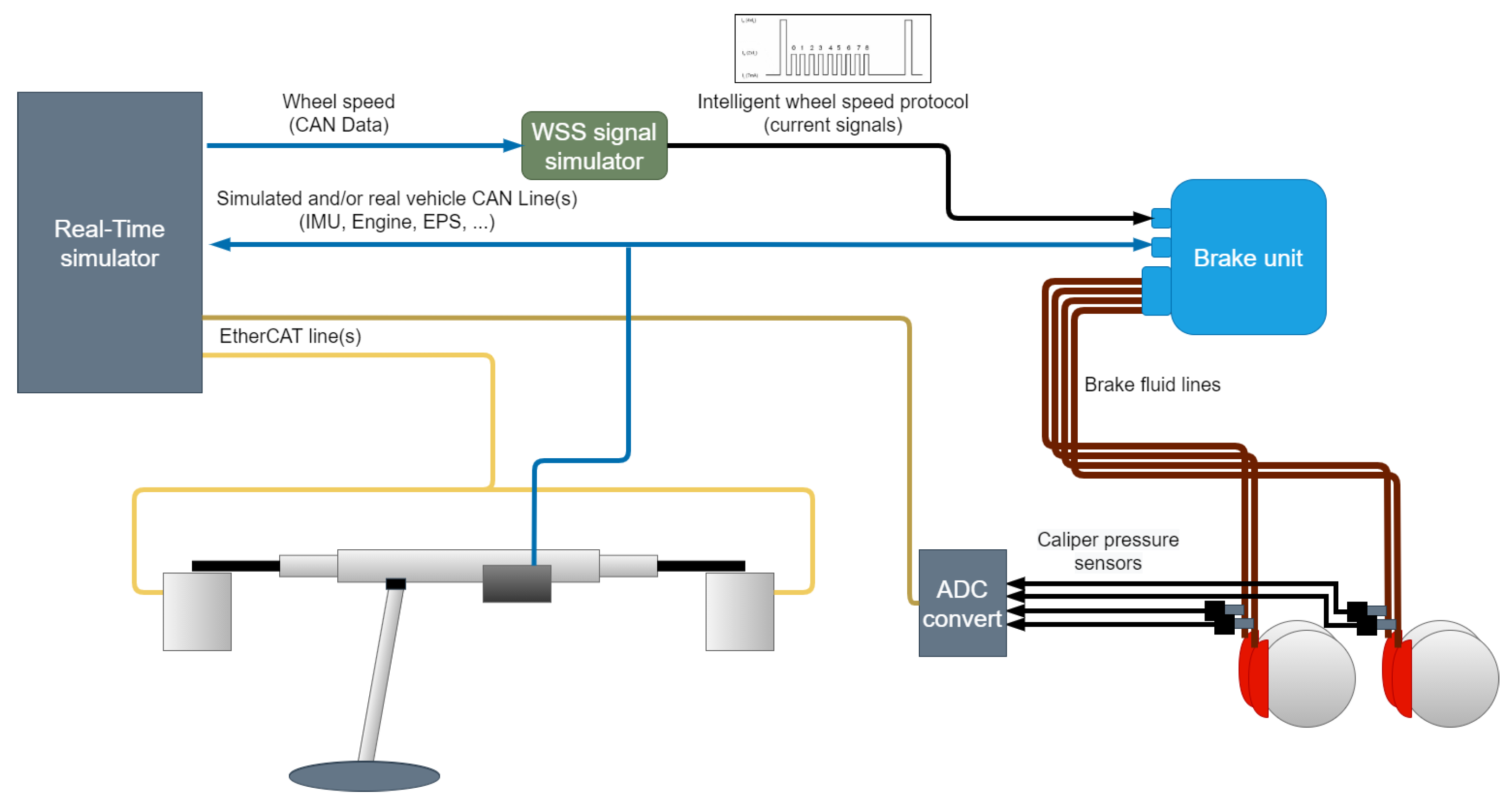
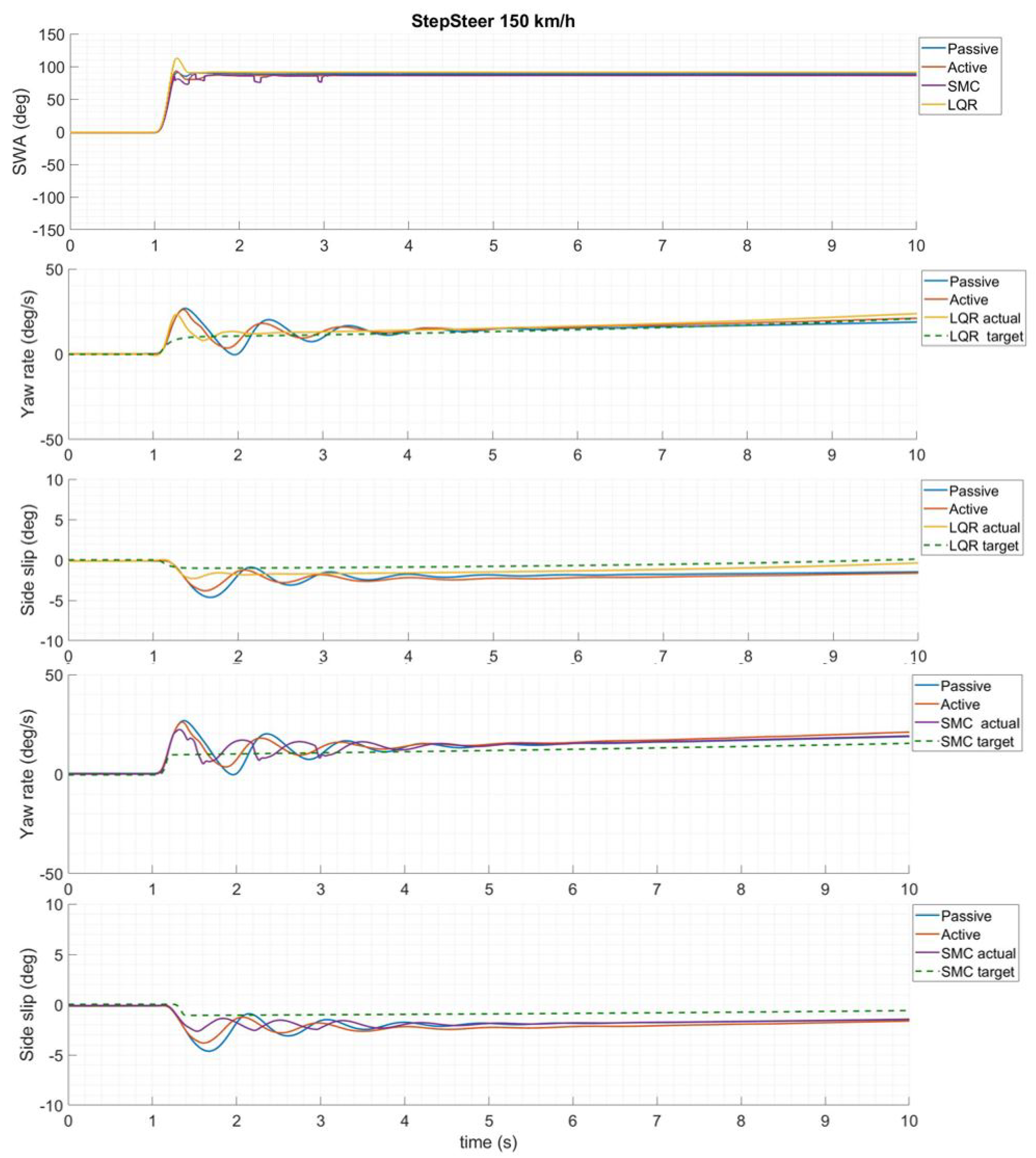
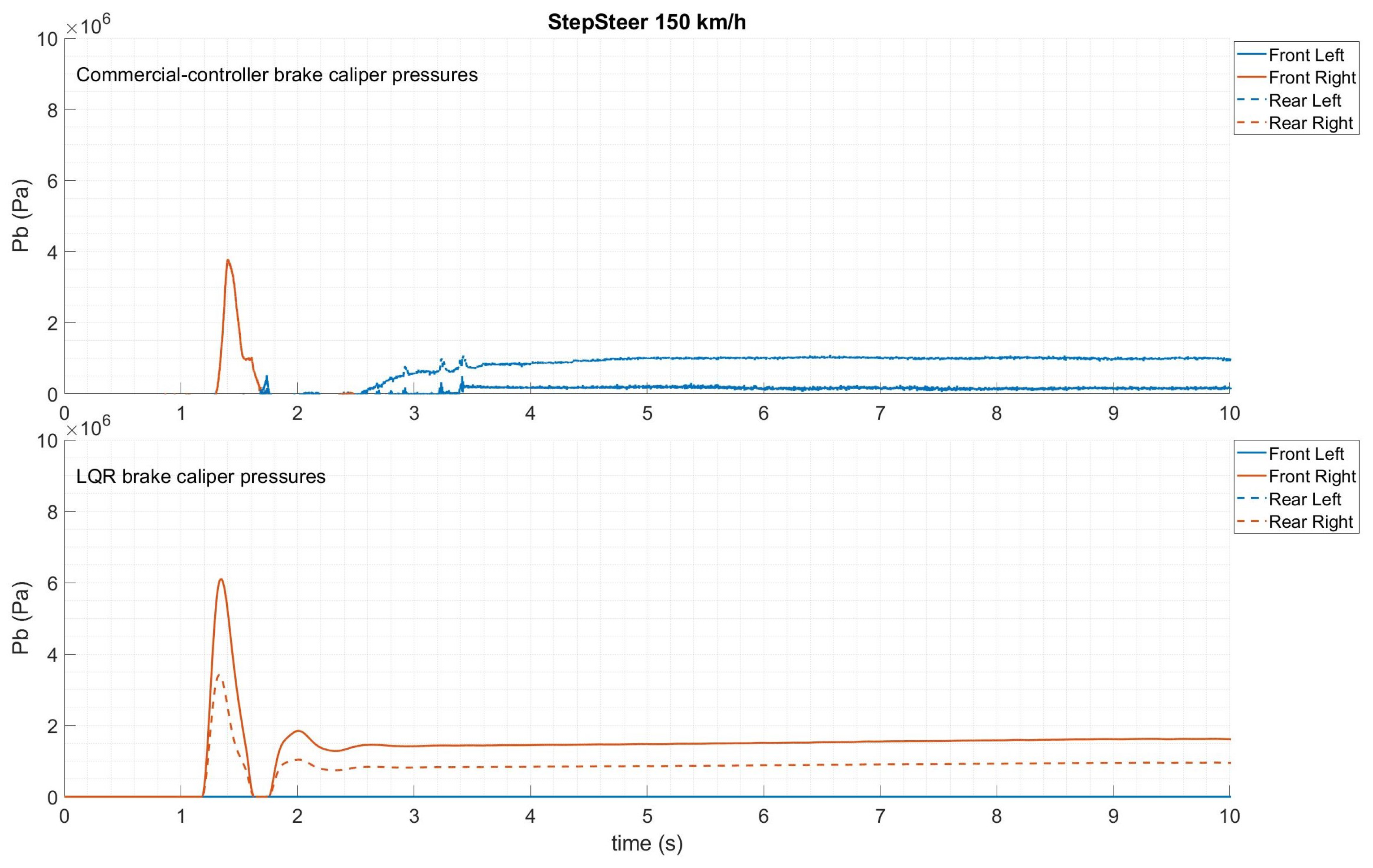


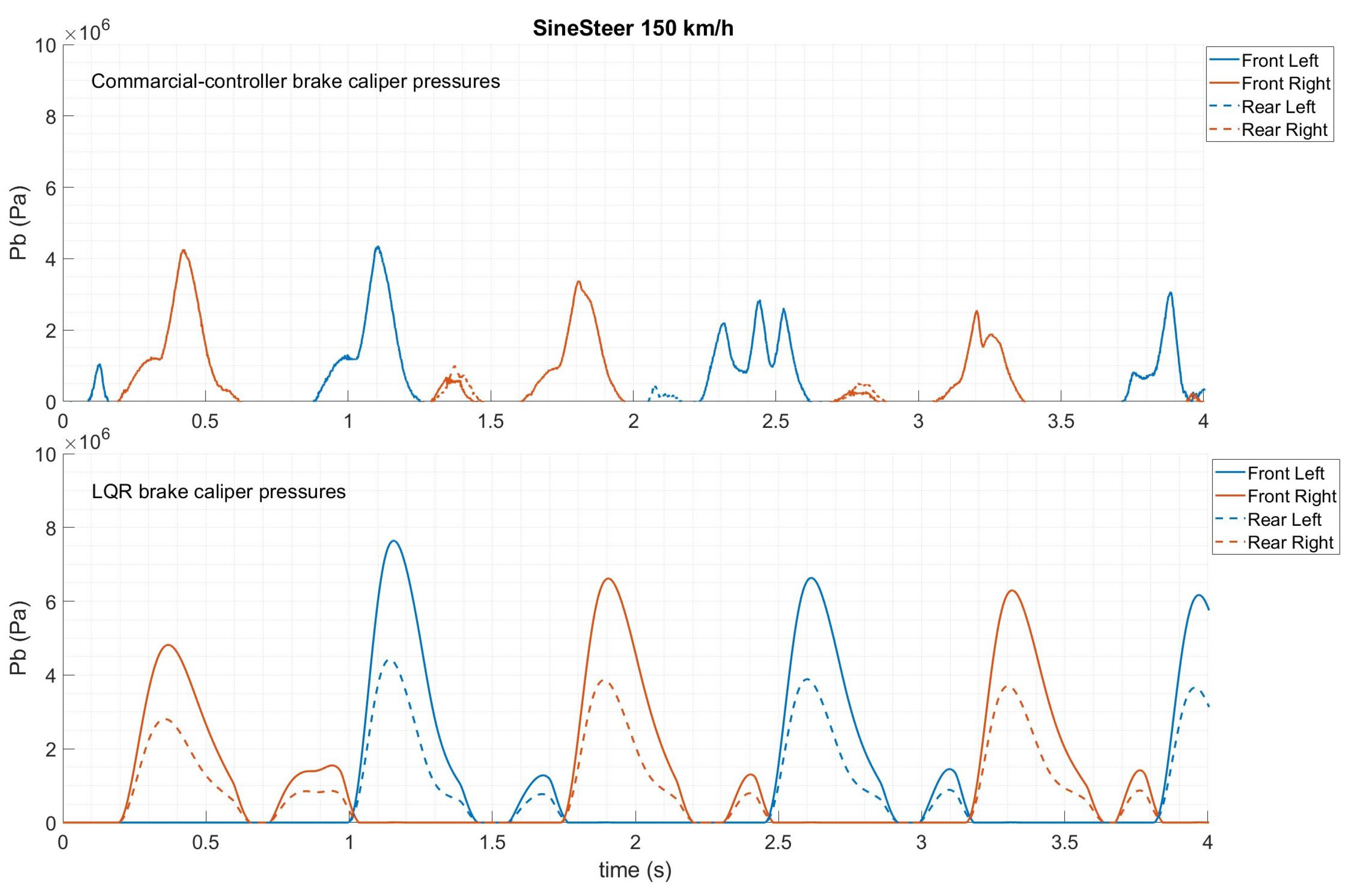
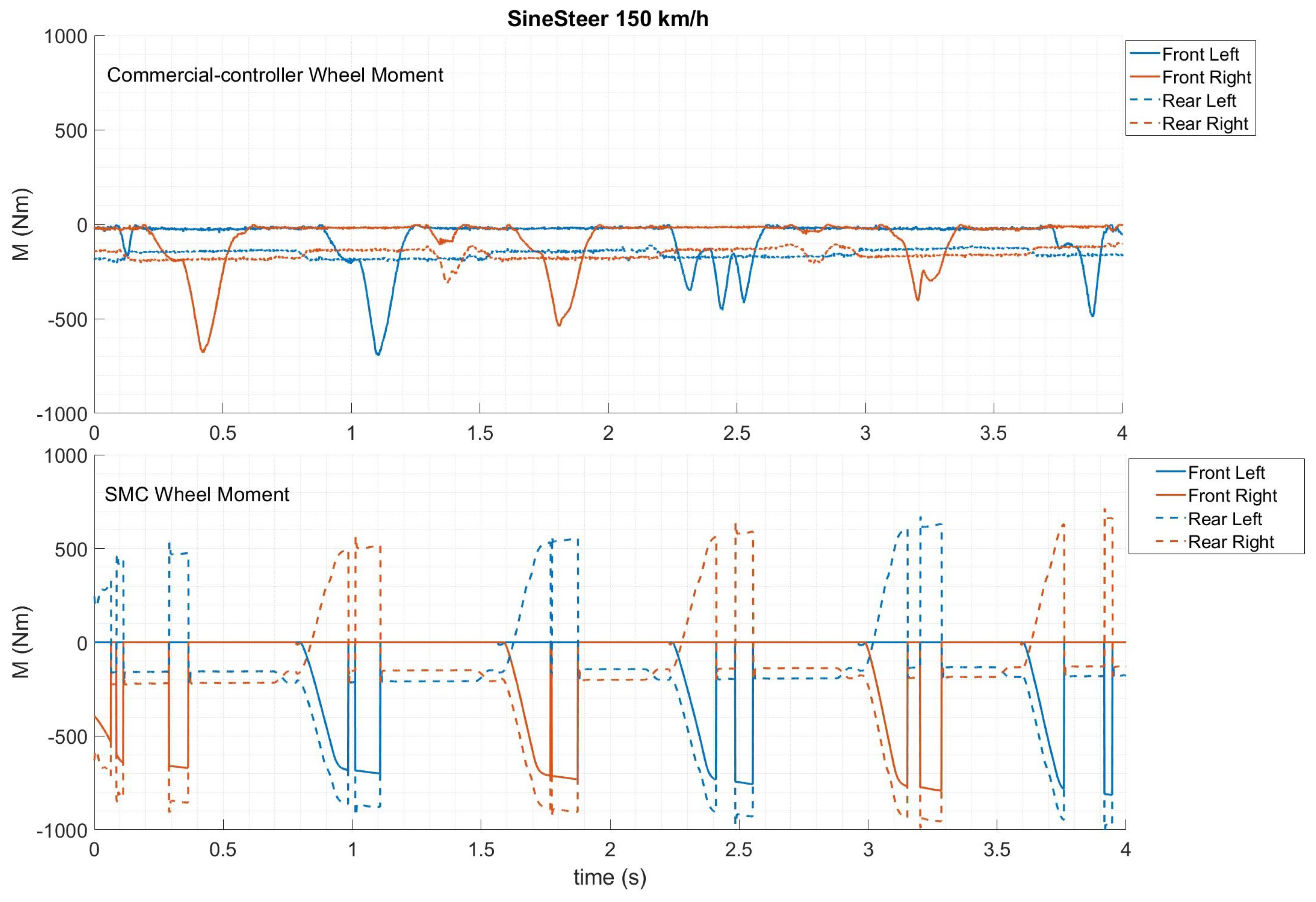
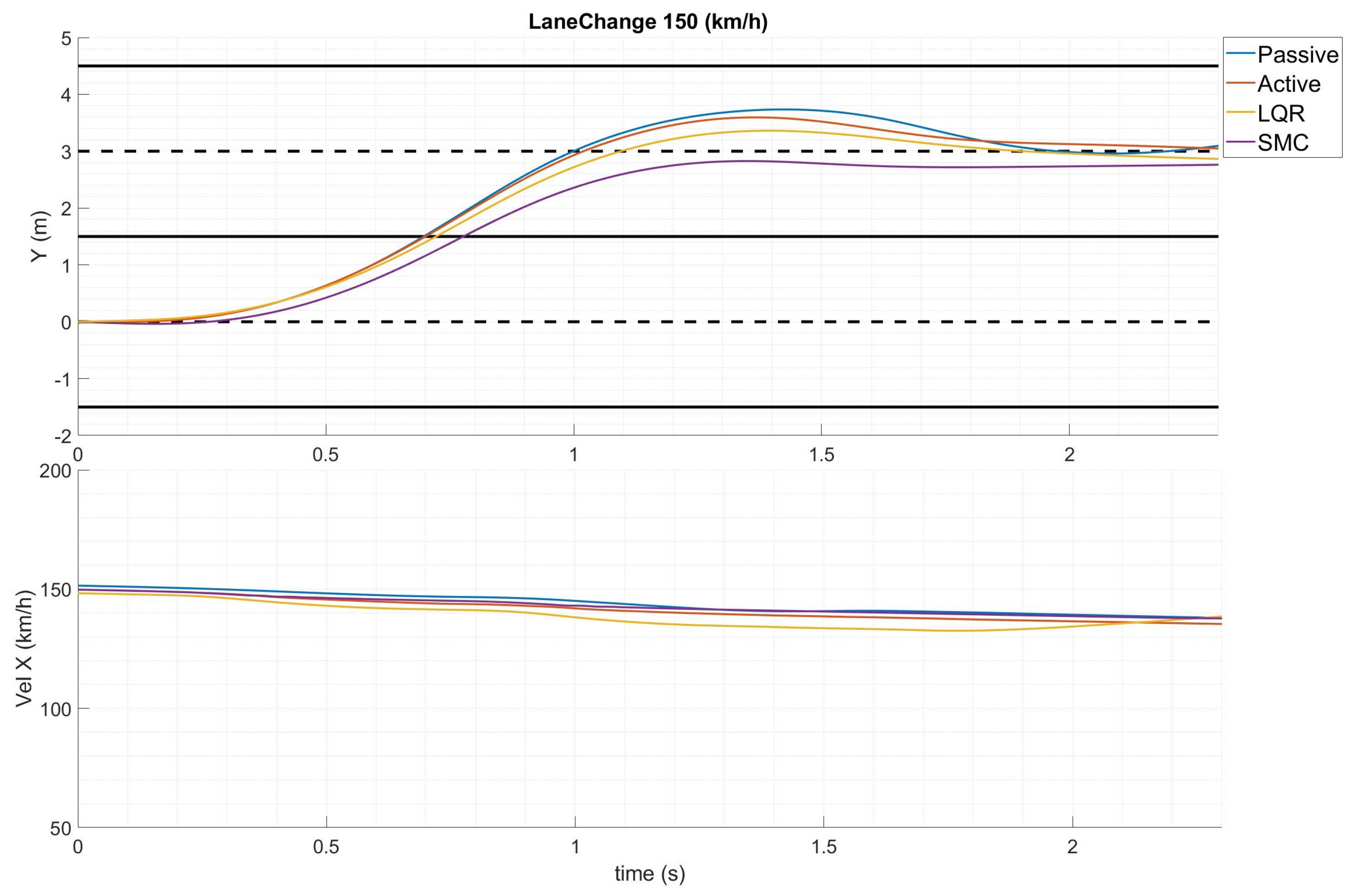
| Name | Standard | Purpose |
|---|---|---|
| Ramp Steer | FMVSS No.126 & ISO 19364:2016 | Calibration |
| Step Steer | ISO 7401:2003 | Calibration & Validation |
| Sine Steer | ISO 7401:2003 | Validation |
| Lane-Change | ISO 3888-1:2018 | Validation |
Disclaimer/Publisher’s Note: The statements, opinions and data contained in all publications are solely those of the individual author(s) and contributor(s) and not of MDPI and/or the editor(s). MDPI and/or the editor(s) disclaim responsibility for any injury to people or property resulting from any ideas, methods, instructions or products referred to in the content. |
© 2023 by the authors. Licensee MDPI, Basel, Switzerland. This article is an open access article distributed under the terms and conditions of the Creative Commons Attribution (CC BY) license (https://creativecommons.org/licenses/by/4.0/).
Share and Cite
Alfatti, F.; Montani, M.; Favilli, T.; Annicchiarico, C.; Berzi, L.; Pierini, M.; Pugi, L.; Capitani, R. Implementation and Performances Evaluation of Advanced Automotive Lateral Stability Controls on a Real-Time Hardware in the Loop Driving Simulator. Appl. Sci. 2023, 13, 6592. https://doi.org/10.3390/app13116592
Alfatti F, Montani M, Favilli T, Annicchiarico C, Berzi L, Pierini M, Pugi L, Capitani R. Implementation and Performances Evaluation of Advanced Automotive Lateral Stability Controls on a Real-Time Hardware in the Loop Driving Simulator. Applied Sciences. 2023; 13(11):6592. https://doi.org/10.3390/app13116592
Chicago/Turabian StyleAlfatti, Federico, Margherita Montani, Tommaso Favilli, Claudio Annicchiarico, Lorenzo Berzi, Marco Pierini, Luca Pugi, and Renzo Capitani. 2023. "Implementation and Performances Evaluation of Advanced Automotive Lateral Stability Controls on a Real-Time Hardware in the Loop Driving Simulator" Applied Sciences 13, no. 11: 6592. https://doi.org/10.3390/app13116592
APA StyleAlfatti, F., Montani, M., Favilli, T., Annicchiarico, C., Berzi, L., Pierini, M., Pugi, L., & Capitani, R. (2023). Implementation and Performances Evaluation of Advanced Automotive Lateral Stability Controls on a Real-Time Hardware in the Loop Driving Simulator. Applied Sciences, 13(11), 6592. https://doi.org/10.3390/app13116592








